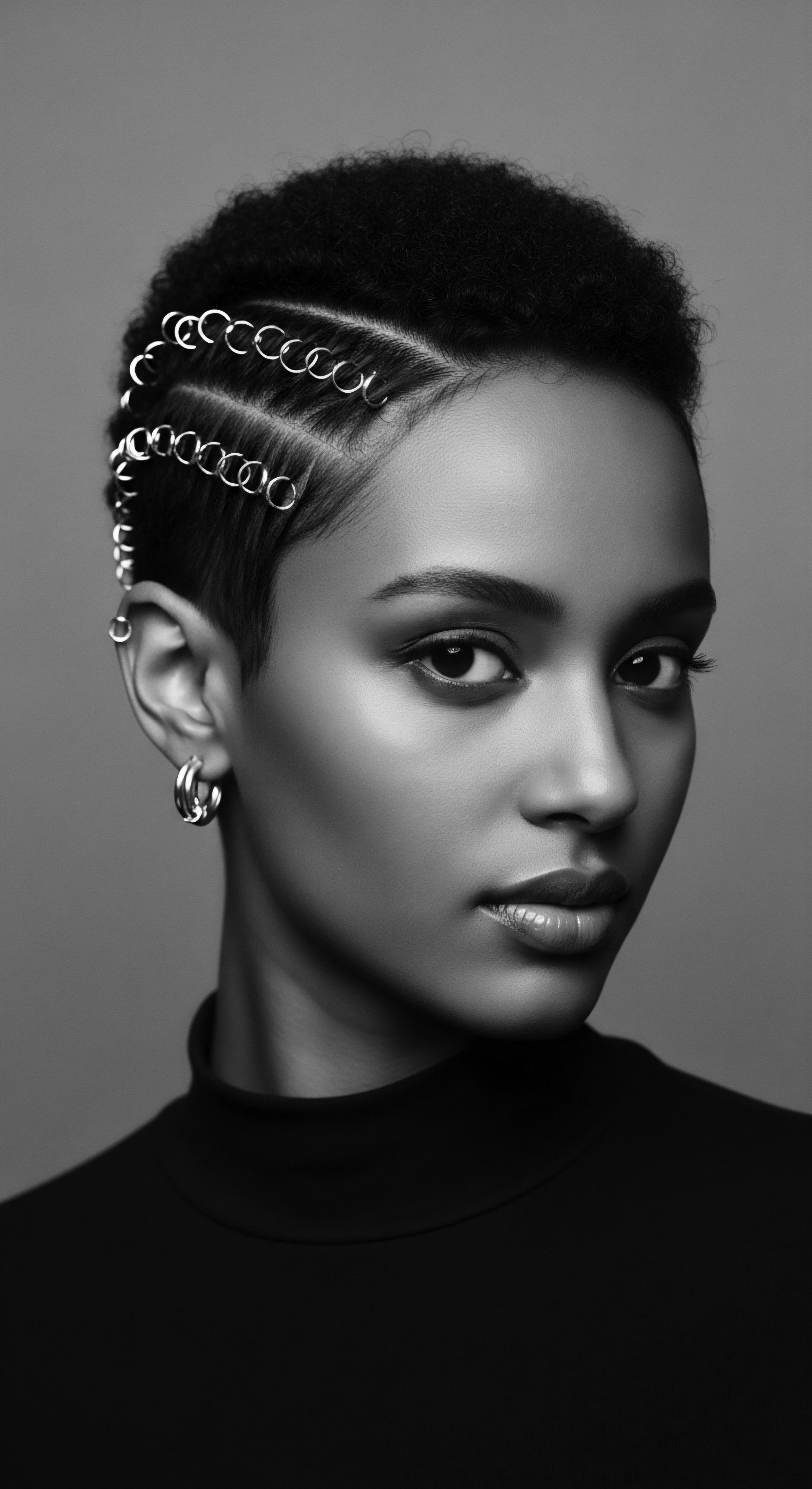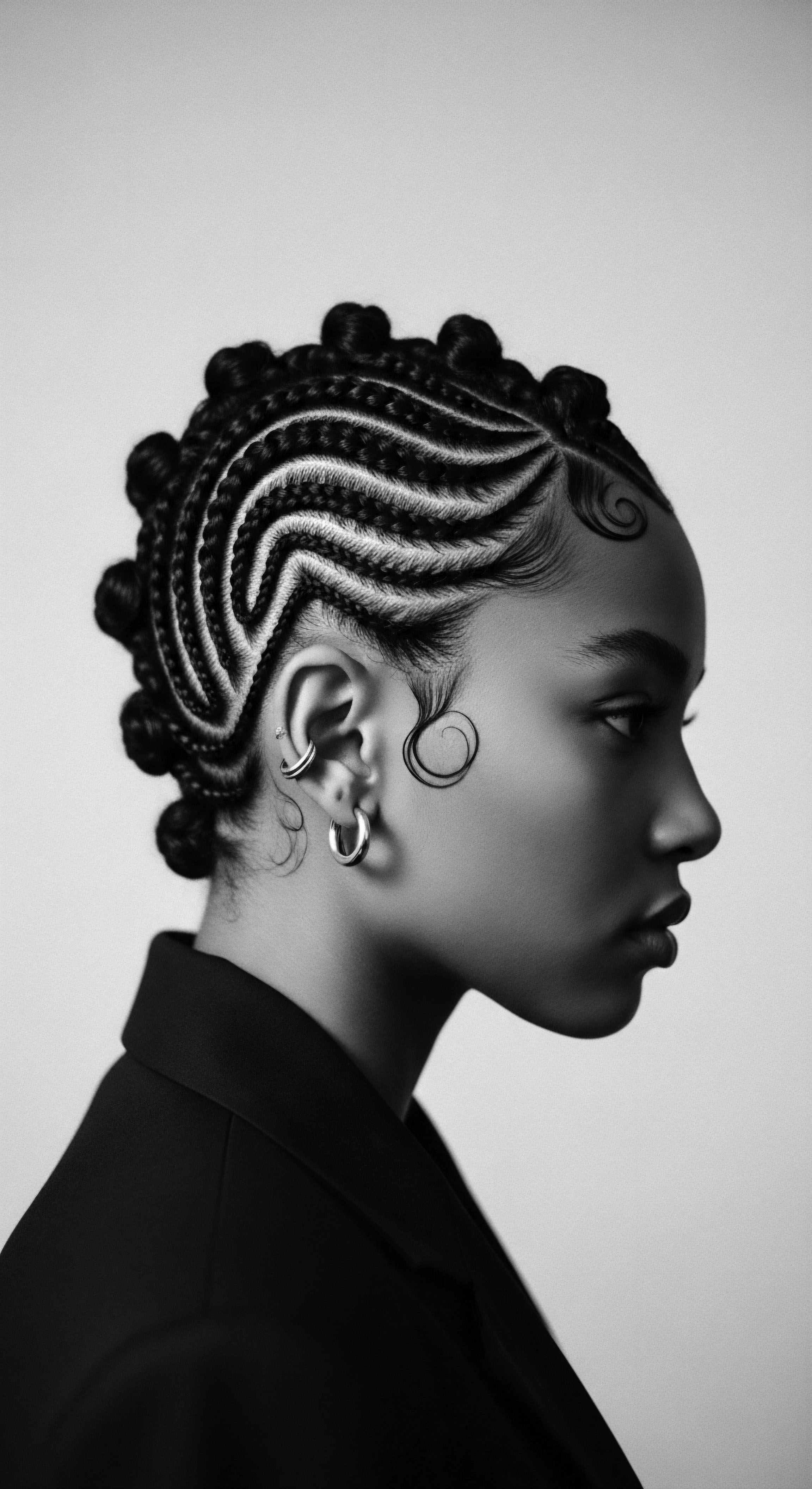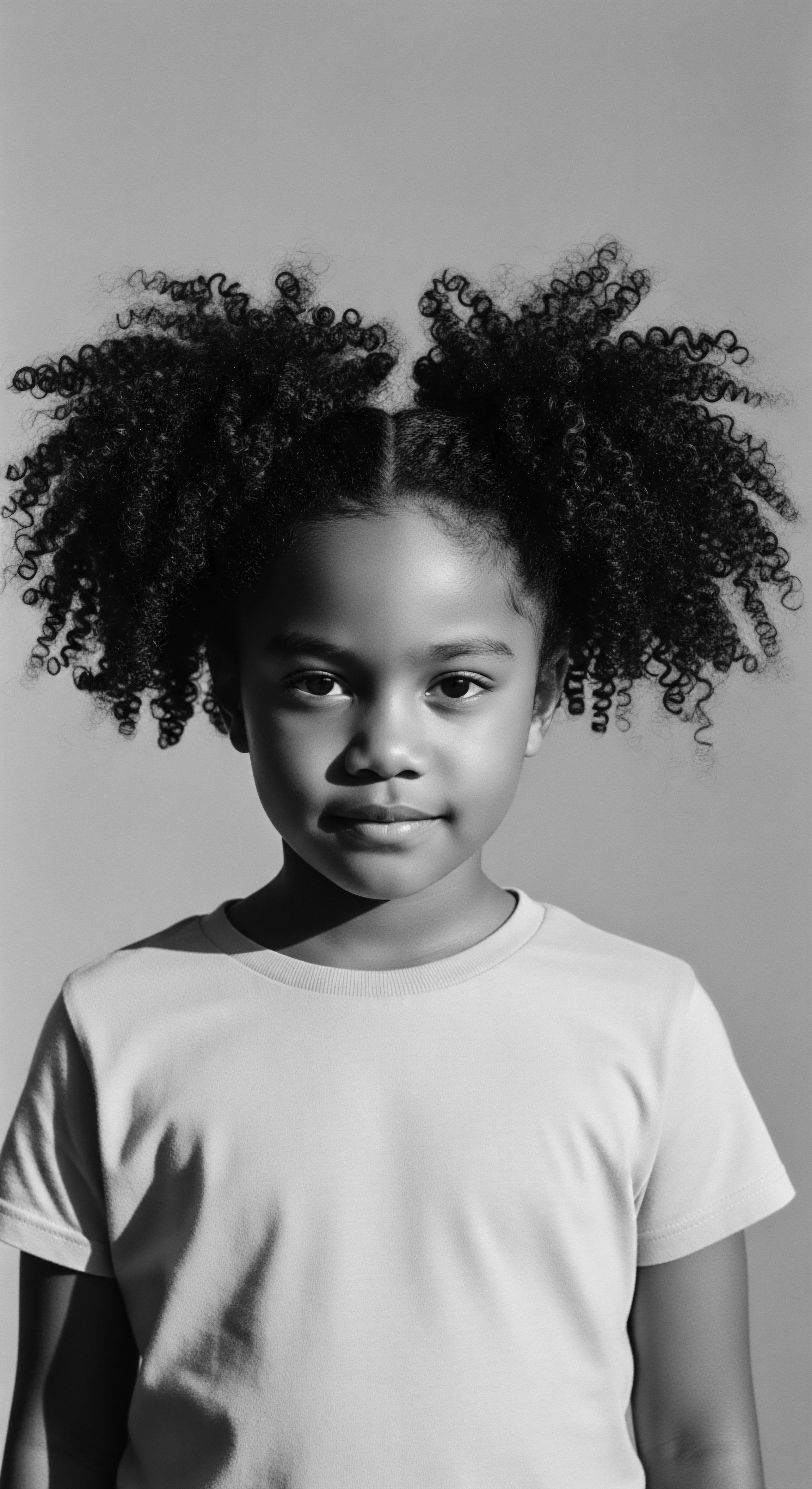
Fundamentals
The notion of ‘Hair Health Black Women’ extends beyond the superficial sheen of a well-conditioned strand; it represents a profound meditation on the well-being of textured hair, deeply rooted in its ancestral lineage and the unique experiences of Black and mixed-race communities. It describes the holistic state of a Black woman’s hair, considering not just its physical vitality—its strength, moisture balance, elasticity, and growth—but also its psychological weight, its cultural resonance, and its historical journey. This comprehension acknowledges that hair for Black women serves as a vibrant, living archive, holding stories of resilience, identity, and generational wisdom.
From its elemental biology, where each coil and kink tells a story of unique structural considerations, to the ancient practices that nurtured these distinct textures, the health of Black women’s hair has always been inextricably linked to a deeper cultural understanding. This initial explanation aims to clarify this foundational concept, laying the groundwork for a richer appreciation of its layered significance. It’s about recognizing the intrinsic value of every strand, understanding its inherent capabilities, and honoring the deep cultural meanings it carries. A focus on hair health for Black women involves understanding that the practices of care are often acts of self-affirmation, heritage preservation, and community connection.
Hair Health Black Women signifies a holistic state of well-being for textured hair, intrinsically linked to its cultural heritage and the collective journey of Black and mixed-race communities.

Foundational Elements of Textured Hair Well-Being
To grasp the definition of Hair Health Black Women, one must first appreciate the inherent architecture of textured hair. Unlike straighter hair types, coiled, kinky, and curly strands possess specific structural characteristics that dictate their care requirements. The elliptical shape of the hair follicle, which gives rise to the characteristic curl, creates points of vulnerability along the hair shaft where the cuticle layers are more prone to lifting and breakage. This structural attribute means natural oils from the scalp travel less efficiently down the strand, making textured hair more susceptible to dryness.
- Coil Pattern ❉ The tighter the curl, the more turns and twists a single strand possesses, leading to increased points of potential fragility and reduced ability for natural sebum to coat the entire length.
- Cuticle Integrity ❉ A healthy cuticle layer lies flat, protecting the inner cortex. For textured hair, environmental stressors and improper handling can more readily disrupt this protective layer, leading to moisture loss and a rough texture.
- Moisture Balance ❉ This is a paramount consideration. The intrinsic structure of textured hair often necessitates a proactive approach to hydration, drawing from both ancestral wisdom and contemporary scientific insights to maintain pliability and strength.
- Elasticity ❉ The ability of hair to stretch and return to its original state indicates its internal health. Hair with good elasticity resists breakage and retains its shape, a quality vital for vibrant, lively curls and coils.
Understanding these elemental biological aspects forms the initial step in comprehending the larger sphere of Hair Health Black Women. It establishes why specific care regimens, often passed down through generations, became essential for nurturing these unique hair types. The practices were not arbitrary; they were responses to the hair’s fundamental needs, honed through centuries of observation and communal knowledge.

Intermediate
Moving beyond the foundational tenets, the intermediate appreciation of ‘Hair Health Black Women’ deepens into the living traditions of care and their interplay with modern insights. This understanding acknowledges that the meaning of hair health for Black women is not static; it has evolved, adapting to changing environments, societal pressures, and the reclamation of ancestral pride. It encompasses the practices, rituals, and communal bonds that have historically sustained and continue to shape the vitality of Black and mixed-race hair.
This level of insight recognizes that the tender thread of care extends from individual acts to collective cultural expressions. The meticulous detangling, the strategic application of natural emollients, the communal braiding sessions—each act carries a dual significance ❉ providing physical nourishment to the hair and reinforcing a sense of belonging and cultural continuity. These are not merely grooming routines; they are enduring traditions that carry the weight of history and the promise of future generations.
The intermediate understanding of Hair Health Black Women encompasses the evolving care traditions, communal rituals, and deep cultural connections that shape its holistic well-being.

The Tender Thread of Care ❉ Evolving Traditions
The journey of Hair Health Black Women across centuries reflects a dynamic adaptation. From pre-colonial African societies, where hair styling was an elaborate art form denoting status, age, marital status, and tribal affiliation, to the harsh realities of enslavement where hair care became a clandestine act of resistance and self-preservation, the methods and meanings have shifted. Yet, a constant thread remains ❉ the dedication to nurturing these distinct textures.
In many ancestral African societies, hair care was a communal affair, a ritual passed from elder to youth. Indigenous ingredients—from various plant oils and butters to clays and herbal infusions—were meticulously prepared and applied. These practices were often embedded within ceremonies, reinforcing the spiritual and social significance of hair.
The act of tending to one another’s hair built intergenerational bonds and preserved a rich knowledge system. These traditions, though sometimes fragmented or altered by diaspora, persist as the bedrock of contemporary Black hair care.
| Traditional Practice/Ingredient Communal Grooming Sessions |
| Ancestral Significance/Use Strengthening social bonds, intergenerational knowledge transfer, ritualistic importance, identity affirmation. |
| Modern Parallel/Scientific Insight Hair salons as community hubs, natural hair meetups, online communities sharing care tips; recognition of shared experiences and collective identity through hair. |
| Traditional Practice/Ingredient Plant-based Oils & Butters |
| Ancestral Significance/Use Lubrication, sealing moisture, environmental protection, traditional remedies for scalp conditions (e.g. shea butter, palm oil). |
| Modern Parallel/Scientific Insight Contemporary use of natural oils (e.g. argan, jojoba, coconut) for similar purposes; scientific validation of fatty acid profiles and their benefits for hair and scalp health. |
| Traditional Practice/Ingredient Protective Hairstyles (Braids, Twists) |
| Ancestral Significance/Use Displaying status, communicating tribal affiliation, protecting hair from environmental elements, promoting length retention by minimizing manipulation. |
| Modern Parallel/Scientific Insight Continued popularity of braids, twists, and locs as low-manipulation styles; understanding of reduced breakage and growth promotion through minimizing daily styling stress. |
| Traditional Practice/Ingredient Herbal Rinses & Cleansers |
| Ancestral Significance/Use Cleansing, stimulating the scalp, conditioning, addressing specific concerns with indigenous plants. |
| Modern Parallel/Scientific Insight Adoption of 'co-washing' (conditioner-only washing), clay washes (e.g. bentonite, rhassoul), and apple cider vinegar rinses for gentle cleansing and pH balancing. |
| Traditional Practice/Ingredient The enduring wisdom of ancestral practices continues to shape and inform contemporary approaches to Hair Health Black Women, bridging historical knowledge with present-day understanding. |

Navigating Modernity ❉ Challenges and Adaptations
The concept of Hair Health Black Women today grapples with a legacy of external pressures that have, at times, sought to diminish or devalue natural Black hair textures. From the pervasive messaging that equated straight hair with professionalism or beauty to the economic accessibility of chemical relaxers, choices surrounding hair health have often been intertwined with survival and societal acceptance. This historical backdrop lends a unique dimension to the contemporary pursuit of hair health, making it an act of reclaiming autonomy and celebrating inherent beauty.
The transition from chemical processing to natural hair care, for many, represents a deliberate choice to reconnect with their heritage and prioritize long-term hair vitality. This shift requires unlearning previous notions of “manageability” and embracing the intrinsic qualities of textured hair. It involves discerning ingredients, understanding product efficacy, and developing routines that honor the hair’s unique needs, often echoing principles rooted in ancestral care, albeit with modern tools and formulations. The choices made around care become a continuous dialogue between inherited wisdom and contemporary knowledge.

Academic
The academic understanding of ‘Hair Health Black Women’ constitutes a sophisticated synthesis of trichology, cultural anthropology, sociological inquiry, and historical analysis. It describes the optimal physiological and psychosocial condition of hair within individuals of Black or mixed-race heritage, recognizing that hair vitality is deeply interconnected with identity, self-perception, and community well-being. This comprehensive delineation extends beyond mere cosmetic attributes, viewing hair as a dynamic bio-cultural artifact, a repository of ancestral memory, and a powerful medium for expressing individual and collective narratives. The meaning of Hair Health Black Women is, therefore, a multi-dimensional construct, meticulously built upon the intricate interplay of genetic predispositions, environmental factors, historical systemic pressures, and the enduring legacy of care practices spanning millennia.
A rigorous examination of Hair Health Black Women necessitates dissecting the elemental biology of highly coiled and kinky hair types, which often present distinct challenges related to moisture retention and structural integrity, as previously discussed. These biological nuances, however, gain their profound significance when viewed through the lens of historical oppression and cultural resilience. Hair health, in this academic context, becomes a barometer for the broader experiences of Black women—reflecting periods of cultural suppression, acts of quiet defiance, and vibrant movements of self-acceptance and affirmation. The exploration here seeks to bridge the chasm between cellular mechanics and societal movements, identifying how each informs the other in the persistent pursuit of textured hair vitality.
Hair Health Black Women, academically considered, integrates trichological understanding with profound cultural, historical, and sociological dimensions, positioning hair as a dynamic bio-cultural artifact.

Echoes from the Source ❉ Bio-Cultural Foundations of Textured Hair
At its very genesis, the biological structure of highly textured hair—characterized by its elliptical cross-section and the unique distribution of disulphide bonds that dictate its tight curl patterns—renders it inherently predisposed to dryness and mechanical breakage. The irregular shape of the follicle, the slow migration of sebum down the spiraling shaft, and the increased number of cuticle lifts at each bend contribute to a naturally drier, more fragile strand when compared to straighter hair types (Draelos, 2011). This elemental biological reality, often framed in a deficit model within mainstream cosmetology, finds its counterpoint in ancestral wisdom. Across various African civilizations, specific care rituals emerged not as a reaction to perceived deficiencies, but as an ingenious adaptation to the hair’s natural characteristics, aimed at optimizing its inherent capabilities.
Consider the profound ancestral knowledge embedded in practices observed among the Basara women of Chad, a tradition that offers an illuminating example of indigenous trichological insight. For generations, these women have applied a unique herbal mixture, predominantly composed of Chebe powder (derived from the Croton zambesicus plant), alongside other plant-based ingredients and oils, to their hair. This ancestral ritual, meticulously passed down through matriarchal lines, involves dampening the hair, coating it with the Chebe mixture, and then braiding it.
The process is repeated over time, forming a protective casing around the hair strands. The sustained length of the Basara women’s hair, often reaching waist or hip length, provides empirical evidence of this method’s efficacy in reducing breakage and promoting retention (Njoku, 2021).
From a scientific viewpoint, while formal large-scale clinical trials on Chebe powder are limited, the observed effects align with modern understandings of hair care. The Chebe mixture, rich in saponins, tannins, and potentially other beneficial compounds, likely acts as an emollient and sealant, coating the hair shaft to prevent moisture loss and reducing friction between individual strands during daily manipulation. This protective layer mitigates mechanical stress, a primary contributor to breakage in highly textured hair. Thus, the ancestral practice, though not articulated in biochemical terms, effectively addressed the biological vulnerabilities of coiled hair by creating an optimal environment for length retention.
This instance strikingly illustrates how millennia of empirical observation and communal transmission of knowledge led to highly effective, culturally embedded hair health strategies. It foregrounds how a comprehensive definition of Hair Health Black Women must integrate this profound ancestral ingenuity with contemporary scientific validation, seeing traditional practices not as archaic, but as living laboratories of applied botanical and structural hair science.

Sociological Vectors and Psychosocial Impact
The historical trajectory of Black women’s hair health has been profoundly shaped by external sociological vectors, particularly the pervasive effects of colonial influence and systemic racism. During enslavement, the deliberate stripping away of cultural identity extended to hair, as traditional grooming practices were disrupted and, at times, forbidden. Hair, once a symbol of status and spiritual connection, became a site of struggle, often concealed or forcibly altered.
The subsequent post-emancipation era saw the rise of straightening practices, initially as a means of assimilation for survival in a racially hostile society, and later normalized through pervasive beauty standards that privileged Eurocentric aesthetics. This historical context reveals that choices around hair care were often not simply about aesthetics or physical health; they were complex negotiations of identity, safety, and economic opportunity.
The long-term psychosocial consequences of these historical pressures on Hair Health Black Women are significant. Generations learned to associate their natural hair with ‘unmanageability’ or ‘unprofessionalism,’ leading to widespread use of chemical relaxers and heat styling, practices known to compromise hair integrity through damage to disulfide bonds and protein denaturation. The definition of ‘healthy’ hair became conflated with ‘straight’ hair, leading to cycles of damage and a disconnect from ancestral textures. The contemporary natural hair movement, therefore, represents a powerful act of collective healing and reclamation.
It signifies a profound shift in the meaning of hair health for Black women ❉ a move from external validation to internal affirmation, prioritizing the inherent vitality of textured hair over imposed aesthetic norms. This movement underscores a collective decision to reconnect with and celebrate the unique genetic heritage manifested in varied curl patterns.
Moreover, the contemporary discourse surrounding Hair Health Black Women extends into critical examinations of product accessibility, ingredient transparency, and the representation of diverse hair textures in media. Research indicates that Black consumers spend a disproportionately higher amount on hair care products, often seeking formulations tailored to their unique hair needs (Nielsen, 2018). This economic reality points to a persistent market gap and highlights the ingenuity within Black communities to create solutions where mainstream industries often fall short. The ongoing demand for authentic, effective, and heritage-informed hair care products reflects a community’s deep commitment to nurturing its hair, embracing its unique qualities, and fostering collective well-being.
- De-Colonization of Beauty Standards ❉ The shift towards celebrating natural textures challenges Eurocentric beauty ideals, redefining beauty on culturally authentic terms.
- Economic Empowerment ❉ The rise of Black-owned hair care brands tailored to textured hair represents a significant economic and cultural empowerment, providing products formulated with understanding and respect for specific hair needs.
- Psychological Liberation ❉ For many, embracing natural hair fosters increased self-esteem, self-acceptance, and a stronger connection to their cultural heritage, moving away from past narratives of perceived inadequacy.
- Intergenerational Dialogue ❉ Natural hair journeys often spark conversations between generations, allowing for the rediscovery of ancestral care techniques and the sharing of experiences regarding hair discrimination and liberation.

Reflection on the Heritage of Hair Health Black Women
The journey through the intricate understanding of Hair Health Black Women reveals a truth far richer than mere physiological maintenance. It stands as a living testament to the enduring spirit of Black and mixed-race communities, a vibrant thread connecting elemental biology to profound cultural meaning. We have traversed the winding paths from the very source of the strand’s unique architecture, through the tender, generational hands that nurtured it with ancestral wisdom, and into the boundless expressions of identity it shapes in the contemporary world. This exploration makes clear that the health of Black women’s hair is not a singular concept, but a dynamic, ever-evolving dialogue between past and present, between science and spirit.
From the communal grooming rituals of ancient African societies, where hair was an eloquent language of social standing and spiritual connection, to the quiet resilience of practices maintained amidst the most harrowing historical ruptures, the hair of Black women has carried stories. It has been a canvas for artistry, a shield against adversity, and a banner of self-reclamation. The wisdom distilled from centuries of care—from the efficacy of indigenous plant compounds like Chebe to the protective ingenuity of braided styles—continues to guide our hands and inform our understanding today.
The Hair Health Black Women, then, ultimately signifies a harmonious convergence ❉ the scientific comprehension of unique hair biology, validated and enhanced by the deep, embodied knowledge of ancestral care. It speaks to a future where every textured strand is honored for its inherent beauty, celebrated for its unique structural capabilities, and understood as a sacred link to a rich and unbroken lineage. It is a continuous narrative of nurture, strength, and unapologetic self-expression, echoing the powerful story of a people. This enduring connection to heritage, deeply embedded within the very fiber of each curl and coil, allows the story of Hair Health Black Women to unfold with boundless possibilities.

References
- Draelos, Zoe Diana. (2011). Hair Cosmetics ❉ An Overview. Cosmetics & Toiletries, Vol. 126, No. 10.
- Nielsen. (2018). Black Impact ❉ Consumer Categories Where Black Consumers Influence Mainstream Trends. Nielsen Holdings plc.
- Njoku, Chidozie F. (2021). Traditional Hair Care Practices of African Women and Their Relevance in Modern Cosmetology. In P. Ameyaw & L. Asiedu (Eds.), African Indigenous Knowledge and the Development of the Continent. Nova Science Publishers.
